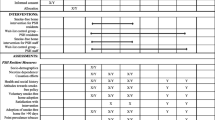Abstract
Interventions to create smoke-free homes typically focus on parents, involve multiple counseling sessions and blend cessation and smoke-free home messages. Smoke-Free Homes: Some Things are Better Outside is a minimal intervention focused on smokers and nonsmokers who allow smoking in the home, and emphasizes creation of a smoke-free home over cessation. The purpose of this study is to conduct moderator analyses using pooled data from three randomized controlled trials of the intervention conducted in collaboration with 2-1-1 contact centers in Atlanta, North Carolina and Houston. 2-1-1 is a strategic partner for tobacco control as it connects over 15 million clients, largely socio-economically disadvantaged, to social and health resources each year. A total of 1506 2-1-1 callers participated across the three intervention trials. Outcomes from 6 months intent-to-treat analyses were used to examine whether sociodemographic variables and smoking-related characteristics moderated effectiveness of the intervention in establishing full home smoking bans. Intervention effectiveness was not moderated by race/ethnicity, education, income, children in the home or number of smokers in the home. Smoking status of the participant, however, did moderate program effectiveness, as did time to first cigarette. Number of cigarettes per day and daily versus nondaily smoking did not moderate intervention effectiveness. Overall, the intervention was effective across socio-demographic groups and was effective without respect to daily versus nondaily smoking or number of cigarettes smoked per day, although smoking status and level of nicotine dependence did influence effectiveness.

Similar content being viewed by others
References
U.S Department of Health and Human Services, Centers for Disease Control and Prevention. (2006). The health consequences of involuntary exposure to tobacco smoke: A report of the surgeon general. Atlanta.
King, B. A., Patel, R., Babb, S. D., Hartman, A. M., & Freeman, A. (2016). National and state prevalence of smoke-free rules in homes with and without children and smokers: Two decades of progress. Preventive Medicine, 82, 51–58.
Nguyen, K. H., Gomez, Y., Homa, D. M., & King, B. A. (2016). Tobacco use, secondhand smoke, and smoke-free home rules in multiunit housing. American Journal of Preventive Medicine, 51, 682–692.
Snyder, K., Vick, J. H., & King, B. A. (2016). Smoke-free multiunit housing: A review of the scientific literature. Tobacco Control, 25, 9–20.
Gehrman, C. A., & Hovell, M. F. (2003). Protecting children from environmental tobacco smoke (ETS) exposure: A critical review. Nicotine & Tobacco Research, 5, 289–301.
Collins, B. N., Nair, U. S., Hovell, M. F., et al. (2015). Reducing underserved children’s exposure to tobacco smoke: A randomized counseling trial with maternal smokers. American Journal of Preventive Medicine, 49, 534–544.
Herbert, R. J., Gagnon, A. J., O’Loughlin, J. L., & Rennick, J. E. (2011). Testing an empowerment intervention to help parents make homes smoke-free: A randomized controlled trial. Journal of Community Health, 36, 650–657.
Streja, L., Crespi, C. M., Bastani, R., et al. (2014). Can a minimal intervention reduce secondhand smoke exposure among children with asthma from low income minority families? Results of a randomized trial. Journal of Immigrant and Minority Health, 16, 256–264.
Priest, N., Roseby, R., Waters, E., et al. (2008). Family and carer smoking control programmes for reducing children’s exposure to environmental tobacco smoke. Cochrane Database of Systematic Reviews, 1(3), CD001746.
Kegler, M. C., Bundy, L., Haardorfer, R., et al. (2015). A minimal intervention to promote smoke-free homes among 2-1-1 callers: A randomized controlled trial. American Journal of Public Health, 105, 530–537.
Williams, R. S., Stollings, J. H., Bundy, L., et al. (2016). A minimal intervention to promote smoke-free homes among 2-1-1 callers: North Carolina randomized effectiveness trial. PLoS ONE, 11, e0165086.
Mullen, P. D., Savas, L. S., Bundy, L. T., et al. (2016). Minimal intervention delivered by 2-1-1 information and referral specialists promotes smoke-free homes among 2-1-1 callers: A Texas generalisation trial. Tobacco Control, 25, i10–i18.
Kreuter, M. W. (2012). Reach, effectiveness, and connections: The case for partnering with 2-1-1 to eliminate health disparities. American Journal of Preventive Medicine, 43, S420–S421.
Purnell, J. Q., Kreuter, M. W., Eddens, K. S., et al. (2012). Cancer control needs of 2-1-1 callers in Missouri, North Carolina, Texas, and Washington. Journal of Health Care for the Poor and Underserved, 23, 752–767.
Norman, G. J., Ribisl, K. M., Howard-Pitney, B., & Howard, K. A. (1999). Smoking bans in the home and car: Do those who really need them have them? Preventive Medicine, 29, 581–589.
Kegler, M. C., & Malcoe, L. H. (2002). Smoking restrictions in the home and car among rural Native American and white families with young children. Preventive Medicine, 35, 334–342.
Orton, S., Jones, L. L., Cooper, S., Lewis, S., & Coleman, T. (2014). Predictors of children’s secondhand smoke exposure at home: A systematic review and narrative synthesis of the evidence. PLoS ONE, 9, e112690.
Centers for Disease Control and Prevention. (2008). Behavioral Risk Factor Surveillance System. Atlanta: Centers for Disease Control and Prevention
Kegler, M. C., Escoffery, C., Groff, A., Butler, S., & Foreman, A. (2007). A qualitative study of how families decide to adopt household smoking restrictions. Family & Community Health, 30, 328–341.
Passey, M. E., Longman, J. M., Robinson, J., Wiggers, J., & Jones, L. L. (2016). Smoke-free homes: What are the barriers, motivators and enablers? A qualitative systematic review and thematic synthesis. BMJ Open, 6, e010260.
Hovell, M. F., Meltzer, S. B., Wahlgren, D. R., et al. (2002). Asthma management and environmental tobacco smoke exposure reduction in Latino children: A controlled trial. Pediatrics, 110(5), 946–956.
Funding
This publication was supported by Grant Number U01CA154282 from the National Cancer Institute.
Author information
Authors and Affiliations
Corresponding author
Ethics declarations
Conflict of interest
The authors have no conflicts of interest to report.
Rights and permissions
About this article
Cite this article
Kegler, M.C., Haardörfer, R., Bundy, L.T. et al. Moderators of Establishing a Smoke-Free Home: Pooled Data from Three Randomized Controlled Trials of a Brief Intervention. J Community Health 44, 121–126 (2019). https://doi.org/10.1007/s10900-018-0561-6
Published:
Issue Date:
DOI: https://doi.org/10.1007/s10900-018-0561-6



